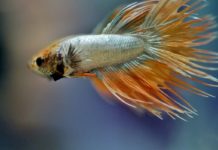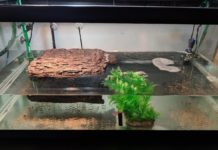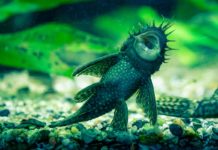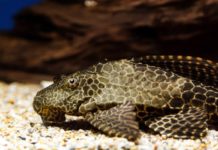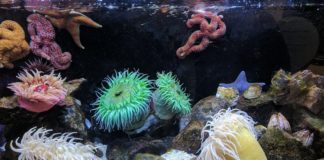Contents
- Cuttlebone For Shrimp – Benefits
- How Much Cuttlebone Should You Add To A Shrimp Aquarium?
- Are Cuttlebones Safe For Shrimp?
- Will Cuttlebone Raise Water pH?
Cuttlebone contains approximately 85% calcium carbonate, making it a great source of calcium for aquarium shrimp. If you’re keeping shrimp this type of bone can be used to keep your aquarium healthier.
You can add cuttlebone into your aquarium which provides a source of calcium or as a way of regulating the kH and pH of the water. Shrimp need calcium for egg development and bone growth. Cuttlebone also acts as a periphyton settlement that provides plankton to aquarium shrimp.
However, a cuttlebone is fragile and may float on water due to its buoyancy, making it difficult to keep in the aquarium at the proper depth. In fact, some aquarium owners think it’s dangerous to have this bone in a freshwater aquarium this isn’t the case if properly done.
Cuttlebone For Shrimp – Benefits
Cuttlebone is made of aragonite, which is a form of calcium carbonate. Calcium is excellent for freshwater aquariums as it helps aquarium shrimp to grow, produce healthy eggs, and even improve the integrity of their shells. Adding cuttlebone in a shrimp aquarium can be an inexpensive way to slowly add calcium to your shrimp tank.
Benefits of putting cuttlebone in your shrimp tank:
1. Maintaining water hardness (kH)
The calcium in cuttlebone is great for maintaining proper water hardness (KH). It helps to absorb any excess nitrates and nitrites produced in the water that by extension helps keep the water safe for shrimp.
If you have an aquarium that has a low kH, adding cuttlebone helps to improve the kH and the water’s buffering qualities. As a result, it becomes much easier to control and maintain the shrimp tank’s pH in a range that’s safer for the type of shrimp you’re keeping.
A single gram of cuttlebone dissolves in water, and yields about 1.5 grams of Bicarbonate, equivalent to 15 mg/L of Calcium Bicarbonate, when added to a 100-liter aquarium.
Calcium bicarbonate contains 75% bicarbonate and 25% calcium, making it a carbonate salt (calcium salt). With every 2 grams of cuttlebone added to aquarium water, you’re increasing the dKH by around 1.
2. Cuttlebone maintains aquarium pH levels
As cuttlebone aids with treating water hardness, it also helps to improve the water’s buffering ability. For most shrimp aquariums, crushed corals or calcium carbonate-based gravels are used as substrates to constantly improve the water’s buffering ability.
You can also add cuttlebone to your shrimp tank as an alternative to using other carbonate and bicarbonate additives. As buffering capacity and pH are intertwined, improving the tank’s water buffering ability also improves the aquarium’s pH stability.
3. It helps egg development
Calcium is an important mineral for the development of eggs for shrimp. Since the development of eggs occurs outside the shrimp body, its mineral content is very important for maturity and integrity.
4. Improves the health of your shrimp
Cuttlebone is high in potassium, iron, zinc, and chlorides. These vital minerals help shrimp grow quicker and live a healthier life. Despite feeding your shrimp a calcium-rich diet, you can still supplement the mineral using cuttlebone especially if you have, a number of shrimps in a 20-gallon tank competing for food.
You can cut, grind, or even powder a cuttlebone to your desired size, amount, and shape before placing it in your shrimp tank to not only make the water taste better but also provide mineral nourishment for your shrimp.
5. Cuttlebone improves shrimp bone growth
Calcium is a major nutritional component for shrimp bone growth and development. A lack of this mineral can easily help with slow growth, and general weakness with aquarium shrimp.
As cuttlebone is soft on the inside and hard on the outside, placing it in a tank, the shrimp can nibble on the soft side and ingest the calcium directly, while the other hard side of the bone can dissolve slowly into the water, therefore, providing a steady supply of calcium to your shrimp.
6. Cuttlebone maintains the biological balance in a shrimp tank
Cuttlebone is a natural source of calcium, which helps to maintain the carbonate hardness in a shrimp tank. As a result, it will hold the biological equilibrium in your aquarium and keep unhealthy organisms away.
7. Cuttlebone enhances aerobic bacterial growth
Cuttlebones offer an excellent surface for bacterial cultures to flourish as they’re porous and contain salt ions (Ca+, Mg+, and K+). This encourages the existence of helpful bacteria in a shrimp aquarium.
8. Cuttlebone improves shell quality
If you’ve noticed a shrimp having a malformed shell, it’s a sign that there’s a calcium deficiency. Adding cuttlebone can help fix malformed decapods.
Calcium and mineral deficiencies affect shell quality, resulting in weaker shrimp shells.
Cuttlebone has a high level of calcium that’s great for adjusting the kH levels in a shrimp aquarium, helping your shrimp to remain healthy. As such, cuttlebone can be used as a natural cost-effective way to add calcium and improve the buffering capacity in your shrimp tank. It also helps regulate the pH level of the water.
How Much Cuttlebone Should You Add To A Shrimp Aquarium?
Every once in a while, you may experience low kH levels in your shrimp aquarium. Various reasons (such as Allophanes) cause the problem. Cuttlebone has a great natural ability to absorb the excess salt and improve the calcium supply in a shrimp tank.
But, how much cuttlebone should you add to your shrimp aquarium?
On average, you can add a quarter to half a teaspoon of cuttlebone into a 10-gallon aquarium however the amount can vary depending on other factors such as the number of shrimp in the tank and the filtration system.
A good rule is to start with a small amount and add more as needed. You can always add more cuttlebone later on. There’s a wide range of opinions regarding adding the right amount of cuttlebone to add to a shrimp aquarium. However, there’s no right or wrong answer. It’s mostly determined by:
- The size of the shrimp tank– If you have a larger shrimp tank, you’ll need to add additional cuttlebone as they would require more calcium for their developing body mass. For example, a 10-gallon tank requires approximately 1/4–1/2 teaspoon cuttlebone for shrimp.
- The number of shrimp in the aquarium– More shrimp means more waste, resulting in an unbalanced biological system. If you have more shrimp in your aquarium, add cuttlebone and additional calcium sources such as calcium additives. Before getting cuttlebone, verify the nutritional guidelines for your shrimp.
- The filtration – As cuttlebones dissolve into calcium carbonate, it’ll affect the pH levels in your shrimp aquarium. But don’t worry; this won’t change your filter’s performance! Rather, you may need to clean them more frequently.
- Caution: Keep a close eye on your shrimp after adding cuttlebone to the tank. If there’s a change in behavior, or a change in the color and behavior, consider removing the cuttlebone.
Are Cuttlebones Safe For Shrimp?
Yes, cuttlebone is safe for shrimp and is an excellent source of calcium for them. It contains natural minerals and nutrients that will benefit a shrimp’s structure and internal organs.
Once you drop the cuttlebone into the aquarium, the shrimp may taste it and consume a lot of bone powder. The most minimally invasive method would be to powder the bone with the tank lights off. You can also cut a cuttlebone in half to minimize mess and clean-up. A little goes a long way, so you can start small, building up as needed.
Will Cuttlebone Raise Water pH?
Yes, cuttlebone is a type of shell that dissolves into calcium carbonate and will change your tank’s pH levels. This is a chemical reaction between the calcium and acid carbonate; therefore, it shouldn’t affect your filter’s performance.
In small doses, it won’t increase water pH at all. However, in larger amounts, cuttlebone can change the pH slightly over a few days.
You can use cuttlebones as part of your shrimp’s diet or as decoration for your aquarium, providing them with the natural minerals they need for good health, such as calcium and magnesium. Some aquarists believe it can help reduce any aggression in the tank.


